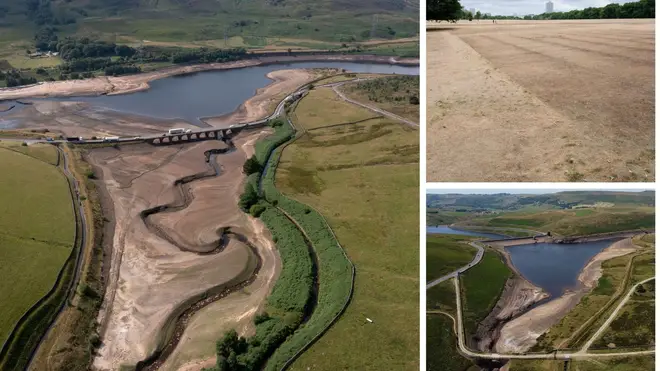
Tom Swarbrick 4pm - 6pm
26 July 2022, 15:51 | Updated: 26 July 2022, 17:57

A drought over summer is "very likely" after the period from January to June this year was the driest in England since 1976, the Met Office has said.
People are being urged to use water wisely as England faces drought in August if the hot and dry weather continues.
The Environment Agency (EA) convened the National Drought Group (NDG) today, with officials from the Environment Department (Defra), water companies, the Met Office, the National Farmers' Union (NFU) and others.
Most of England has moved into "prolonged dry weather" status - meaning the EA is now taking precautionary actions to mitigate the impact of the lack of rainfall.
Firefighters in London have warned of an ‘immediate risk’ of fires due to ‘tinder dry’ grass.
Read more: Heathrow boss blames TikTok fake injury craze for delays hindering disabled passengers

The LFB is urging people to “take extra care and help us prevent fires on open land”.
They are asking people to make sure rubbish, especially glass, is safely thrown away and that cigarettes are properly disposed of.
A drought hasn't been declared yet anywhere in England and most water companies are maintaining good reservoir storage for summer demand.
However, the Royal Meteorological Society told Sky News that a drought was "very likely" for the majority of the south of England and Wales.
The EA said that if further measures are required, hosepipe bans will be determined by individual water companies.
Officials said recent abnormally high temperatures have worsened conditions resulting from lower than normal rainfall so far this year in many parts of England.
The Met Office is forecasting potentially several more dry weeks ahead, particularly in the south and east of the country, so the EA and water companies are now enacting the early stages of their drought plans and calling on everyone to do their bit in managing water use.
The EA takes a broad range of measures to manage drought risk, with many already in action.
Measures include helping those areas which are the worst affected by prolonged dry weather by operating water transfer schemes that allow rivers to be artificially maintained and working with the farming sector to provide greater assistance to farmers in prolonged dry weather areas.
Other measures include reoxygenating water and rescuing fish in distress where river flows are especially low, and supporting the Fire and Rescue Service to tackle waste fires and wildfires.
Harvey Bradshaw, EA executive director for the environment and chair of the NDG, said: "While last week's extreme high temperatures are now behind us and there are currently no plans for restrictions on essential water use, we can all do our bit by reducing unnecessary water consumption and following advice from our water company to ensure this remains the case while our rivers are exceptionally low.
"We are working very closely with water companies, farmers and other water users to manage the current situation.
"Today's meeting was an important step in agreeing joint actions to protect our water resources with further dry weather forecasted for August, including ever-closer working to monitor and manage water supplies and the environment."
Stuart Colville, Water UK director of policy, said: "Ongoing warm weather in much of the country follows the driest winter and spring since the 1970s.
"Water companies have detailed plans in place to manage water resources for customers and the environment, and are doing everything they can, including working closely with government and regulators, to minimise the need for any restrictions and ensure rivers continue to flow.
"As we continue to see extremely high demand, we are urging everyone to carefully consider the amount they are using given the unprecedented conditions."
Much of the country already has low river flows, affecting the quality and quantity of water, with impacts on farmers and other water users, as well as wildlife.
Low groundwater levels, dry soils and low reservoirs have also been seen following months of below average rainfall.
In Yorkshire, the Environment Agency has applied for a drought order for the Holme Styes reservoir in Holmfirth after months of low rainfall, to protect wildlife.
Elsewhere, Southern Water has applied for a drought permit for the River Test in Southampton, Hampshire, amid falling water levels.
The most recent weekly rainfall and river flow summary for England, for the week to Tuesday July 19, said river flows decreased at all but seven sites the EA reports on, with almost all sites classed as below normal and a third being exceptionally low for the time of year.
According to that summary, England has had just 10% of its long-term average (LTA) rainfall for July, with the east and south east recording just 4% of their LTA.
In June, England recorded 74% of its LTA, while the east recorded 67% and the south east recorded 63%.
The last time drought was declared was in 2018.